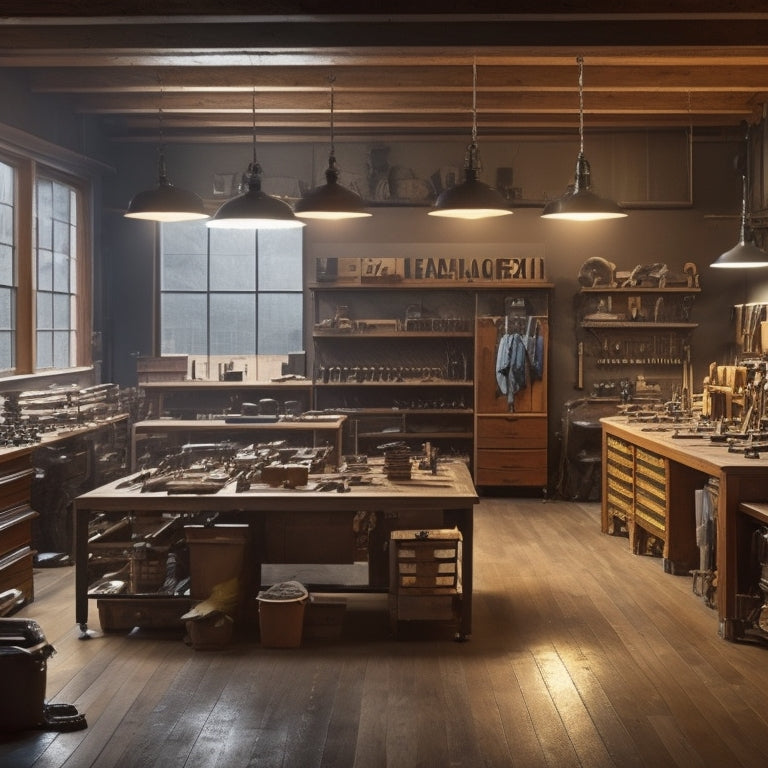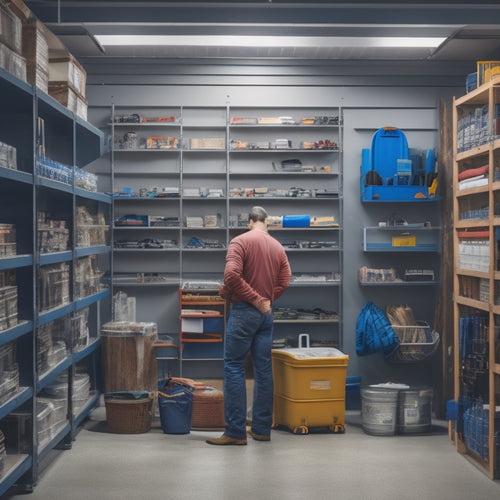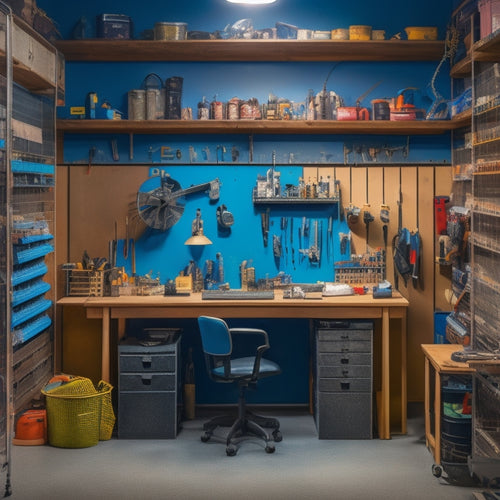
Crafting Your Dream Woodworking Workshop
Share
You're about to transform an ordinary space into a haven of creativity, where every tool, machine, and work surface is meticulously arranged to spark inspiration and foster unbridled productivity. To craft your dream woodworking workshop, start by prioritizing safety with proper tool storage, safety gear, and a first aid kit. Next, optimize your layout for ergonomic design, efficient workflow, and minimal travel time between tools and materials. Invest in essential tools, guarantee a well-lit workspace, and consider a dust collection system. Finally, organize your space for efficiency, align your setup with project needs, and create a functional, inspiring environment that fuels your creativity and propels your projects forward.
Key Takeaways
• Ensure a safe and functional workshop by implementing safety measures, optimizing layout, and investing in essential tools and equipment.
• Organize your workshop for efficiency by implementing modular storage, ergonomic design, and distinct zones for cutting, sanding, and assembly.
• Define clear goals and priorities for your projects and align your workshop setup accordingly to maximize productivity.
• Incorporate creative storage solutions to maximize space, prioritize ventilation, lighting, and electrical considerations for a comfortable workspace.
• Establish a routine for tool maintenance, cleaning, and inspection to ensure a well-maintained workshop and extend the lifespan of your equipment.
Safety First in the Workshop
As you set up your woodworking shop, prioritize safety measures to prevent accidents and promote a healthy working environment.
Starting with proper tool storage and protective gear. Safety gear essentials include safety glasses, ear protection, dust masks, and steel-toed boots.
Make sure you have a first aid kit on hand and a fire extinguisher nearby. Fire prevention measures are vital, so keep flammable materials away from heat sources and guarantee proper ventilation.
Regularly inspect your equipment and cords for damage, and keep your workspace clean and clear of debris.
Optimizing Workshop Layout and Flow
With a well-planned layout, you can maximize your workshop's square footage, streamline your workflow, and boost productivity. To achieve this, focus on workflow optimization and spatial arrangement. This means designing your workshop with functional zones that accommodate different activities, such as a dedicated area for power tools and another for hand tools.
Here are three key considerations for optimizing your workshop layout and flow:
-
Ergonomic design: Position tools and equipment to minimize strain and discomfort, ensuring you can work efficiently and safely.
-
Traffic flow: Design your layout to reduce congestion and bottlenecks, allowing you to move freely and easily around the workshop.
-
Workstation placement: Strategically place workstations to minimize travel time and maximize workflow, reducing the distance between tools and materials.
Essential Tools for Woodworking Success
In your pursuit of woodworking excellence, a well-curated arsenal of essential tools is important for tackling projects efficiently and effectively. You'll need a reliable workbench, power tools like a table saw and miter saw, and hand tools such as chisels and hand planes.
Don't forget safety equipment like goggles, ear protection, and a dust mask. To maintain your tools, establish a regular cleaning and sharpening routine to prevent rust and dullness.
A well-lit workspace with ample ventilation is also essential for accuracy and safety. Make sure your workshop has sufficient lighting, and consider installing a dust collection system to minimize airborne particles.
Organizing for Efficiency and Productivity
You've assembled a solid foundation of tools and equipment, now it's time to optimize your workshop's layout and organization to maximize efficiency and productivity.
A well-organized workshop saves you time, reduces stress, and enhances your overall woodworking experience. To achieve this, focus on the following key areas:
-
Storage solutions: Implement modular and vertical storage options to keep frequently used tools and materials within easy reach, reducing clutter and increasing accessibility.
-
Workspace ergonomics: Design your workspace to promote comfort and reduce fatigue, ensuring your workbench and tools are at best heights and distances to minimize strain.
-
Streamlined workflows: Organize your workflow into distinct zones, separating tasks like cutting, sanding, and assembly to maintain a logical and efficient workflow.
Setting Up for Success
Set clear goals and priorities for your woodworking shop by defining the types of projects you want to tackle, the frequency of use, and the level of complexity, ensuring your setup aligns with your needs and objectives. This will help you create an inspirational design that meets your requirements.
With a clear plan, you can optimize your workshop's layout and organization, incorporating creative storage solutions that maximize space and reduce clutter. By prioritizing your needs, you'll be able to allocate resources efficiently, ensuring a safe and functional workspace.
As you set up for success, remember to take into account factors like ventilation, lighting, and electrical considerations to create a haven that sparks creativity and productivity.
Frequently Asked Questions
How Do I Handle and Store Large, Bulky Woodworking Projects?
When handling and storing large, bulky woodworking projects, you'll want to invest in project cradles, which provide support and protection, while also implementing dust mitigation strategies, like dedicated storage areas and air filtration systems, to prevent damage and mess.
Can I Convert an Existing Garage or Basement Into a Woodworking Shop?
You're transforming a dimly lit cave into a woodworking haven! Converting an existing garage or basement requires strategic planning, including selecting insulation options to regulate temperature and humidity, and designing a thoughtful lighting layout to illuminate your work zone.
What Kind of Flooring Is Best Suited for a Woodworking Workshop?
When choosing flooring for your woodworking shop, you'll want to prioritize safety considerations, such as slip-resistance and durability, opting for flooring options like epoxy-coated concrete, rubber mats, or PVC tiles that can withstand heavy foot traffic and equipment.
How Do I Soundproof a Woodworking Shop to Minimize Noise Disturbance?
As you step into your workshop, imagine the sound of saws and sanders muted, replaced by a soothing silence. To achieve this, you'll install acoustic panels on walls and ceilings, and incorporate noise barriers like mass-loaded vinyl or acoustic caulk to seal gaps.
Can I Share a Woodworking Shop With Multiple Users and Projects Simultaneously?
You can share a woodworking shop with multiple users and projects simultaneously by establishing shop etiquette, creating user schedules, and designating workstations to guarantee a harmonious and productive environment.
Related Posts
-

Best Organizing Tools for a Clutter-Free Space
You're on a mission to change your cluttered space into a peaceful oasis, and you're looking for the best organizing ...
-

Building Garage Shelves in 7 Easy Steps
You're about to convert your garage into a highly functional storage space by building custom shelves in just 7 easy ...
-

3 Key Steps to Streamline Your Workshop Organization
You're likely wasting 30% of your workshop's productivity and profitability due to disorganization, a common problem ...


